Edexcel A-level Geography - The Carbon Cycle
1/192
There's no tags or description
Looks like no tags are added yet.
Name | Mastery | Learn | Test | Matching | Spaced |
|---|
No study sessions yet.
193 Terms
How are tectonic forces a geological carbon release?
- tectonic forces bring carbon rich sedimentary rocks to extreme heat; cause chemical changes and release of carbon dioxide
- subduction zones causes release of carbon dioxide
Why is carbon important?
- climate change and global warming
- rock types and rock cycle
- fossil fuels and type of energy
-ecosystems and photosynthesis
- tropical rain-forests
- coral reefs
- polar regions
- weathering and erosion
- physical geography processes
- plate tectonics and volcanic activity
- weather and climate patterns
- energy production and a consumption processes
Why is carbon important in ecosystems and photosynthesis?
- carbon absorbed for photosynthesis
- allows glucose and oxygen to be released
Why is carbon important for coral reefs?
- placton allow support of coral reef through photosynthesis
- coral store carbon
- coral bleaching
Why is carbon important for polar regions?
- soil carbon is stored in these areas and then released when the ice is melted
How is weathering a geological carbon release?
- rainwater - carbonic acid absorbs carbon dioxide from air and dissolves rock minerals to form new minerals e.g calcium carbonate
- rivers carry minerals to sea to be deposited and buried forming a new rock
What is a petagram?
= gigaton= one quadrillion = 10 to the power of 15
What is a carbon flux?
The movement or transfer of carbon, in different compounds, between stores in atmosphere, biosphere, hydrosphere and lithosphere.
What is residence time?
- how long the carbon says in a store for
How do you work out residence time?
- amount in reservoir
------------------------
flows in or out
What are some examples of geological carbon release?
- chemical weathering
- tectonic forces; volcanic activity
What are the two important roles of carbon in the biosphere?
- primary component of all living tissue
- in gaseous forms CH4 and C02 warms earth surface enough to support life
What is beneficial about the reactions of carbon to the carbon cycle?
- they are exothermic and endothermic
Gross Primary Production (GPP)
- total amount of carbon fixed in
- expressed in grams of carbon or kg of carbon per unit time usually per year
Net Primary Production (NPP)
- carbon that is not released back into the atmosphere via plant respiration
Geological carbon cycle
- volcano gives out carbon dioxide
- carbon dioxide dissolves
- forms a cloud
- carbonic acid rain released from clouds
- weathers rock such as limestone
- calcium carbonate formed
- rivers carry to sea
- deposited and buried
- form new rock
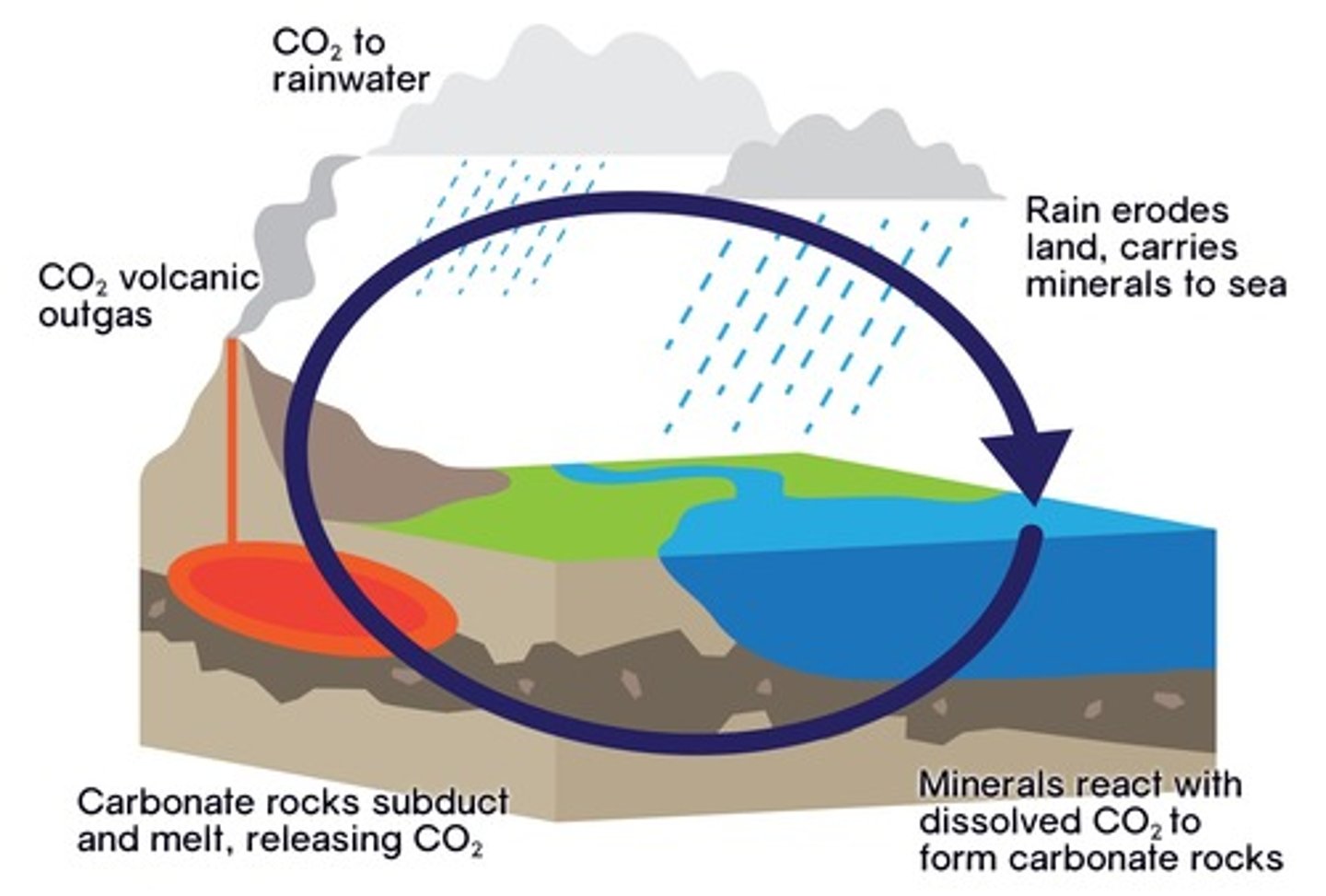
Weathering process of the geological carbon cycle
- most rock starts of as granite
- some granite weathers into clay
- rest of granite eventually weathers into limestone
How is crude oil formed?
- carbon dioxide dissolved into seawater
- 1m layer of fine grained sediments and biological degradation formed
- chemical reactions between carbon dioxide and seabed layer
- at temp. Of 10.c compaction takes place
- more chemical reactions at depth of 10m take place
- creation of insoluble geopolymer compound
- cementation
- depth of 1000m thermocatalytical reactons - cause diagenesis
- mature source rock forms
- at 2500m formation of crude oil and natural gas

How is limestone formed?
- shells and skeletons containing carbon fall to sea floor
- layer of calcareous ooze formed 0-1m
- 0-1m 10.c compaction with calcium carbon detritus over 30% with 40-80% spaces
- 100m cementation begins to take place
- compacted ooze formed with dissolved particles and recrystallisation with very few spaces at 40.c
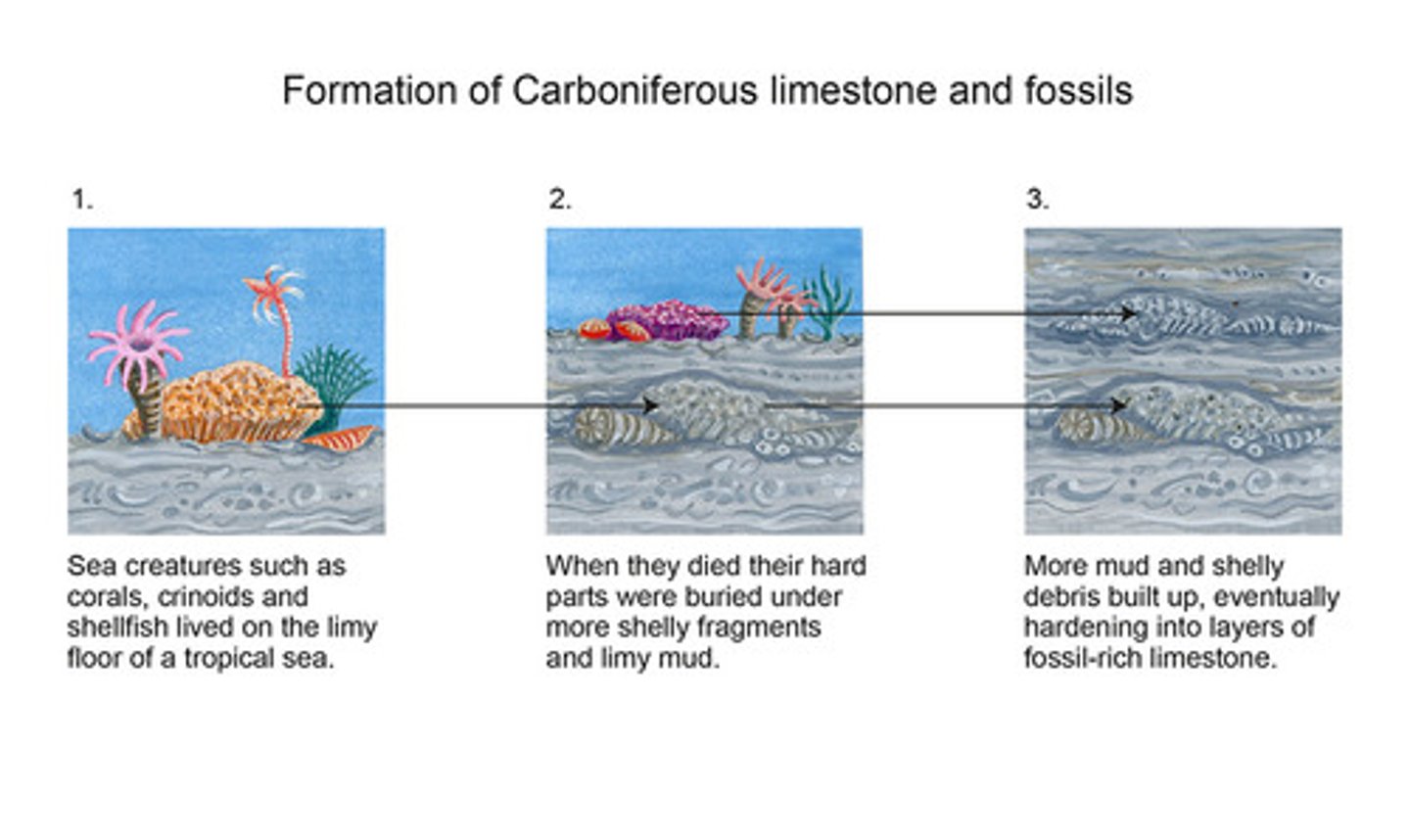
How does carbon get 'locked' in storage as part of the long term geological cycle?
- dissolved carbon deposited on sea bed
- remains of land based plants form peat and then coal
- anthracite(coal)- high temp. And pressure concentrate carbon
- anaerobic reactions convert organic carbon into crude oil
- migrates to porous rocks
- natural gas e.g methane MH4 created during coal and oil formation
- black shales contain organic material may become shale oil and natural gas
- calcuim carbonate left from water when evaporates
biological carbon pump
- ocean's biologically driven sequestration of carbon from atmosphere to deep sea
Thermohaline conveyor
- slow large scale seawater movement between all oceans caused by difference in temperature and density
How does the biological carbon pump operate?
- phytoplankton use sunlight to turn carbon into organic matter through photosynthesis
- carbon enters food web via other organisms use carbon to make shells and skeletons e.g corals and crabs
- living organism move carbon from atmosphere to shallow ocean then deep ocean where die and sink
Why can the amount of phytoplankton be significant?
- when less phytoplankton there will be more carbon so sea less acidic which can harm marine life
How does the marine carbonate pump operate?
- living organisms move carbon from atmosphere to shallow ocean
- then to deep ocean where organism die and sink
- carbonate material accumulates on seabed
- turns into sedimentary rocks
How does the thermohaline conveyor operate?
- combination of transfer of water between 5 global oceans
- warm water rises
- cold and salty water sinks
- water goes to sink area and creates current
- density of water increases
- southern oceans show solubility or physical carbon pump involving upwelling and downwelling currents - more dissolved carbon dioxide
- cold denser seawater sinks into deep ocean, slow moving deep ocean currents hold carbon dioxide
- deep currents return to surface= seawater warmed and carbon dioxide diffused back to atmosphere
- carbon compounds transported between world's oceans in this way
Short way of how thermohaline conveyor operates
- cold water sinks
- currents hold carbon dioxide
- return to surface
- seawater warmed
- co2 diffused back into atmosphere
Phytoplankton
- account for roughly half of the net photosynthesis on earth
- nutrient sources for marine organisms in a balanced ecosystem
- phytoplankton grow out of control form algal blooms - produce extremely toxic compounds affecting marine life
- blooms started by any process that disturbs natural balance between phytoplankton and their predator
- environmental conditions that affect blooms often those that impact climate change
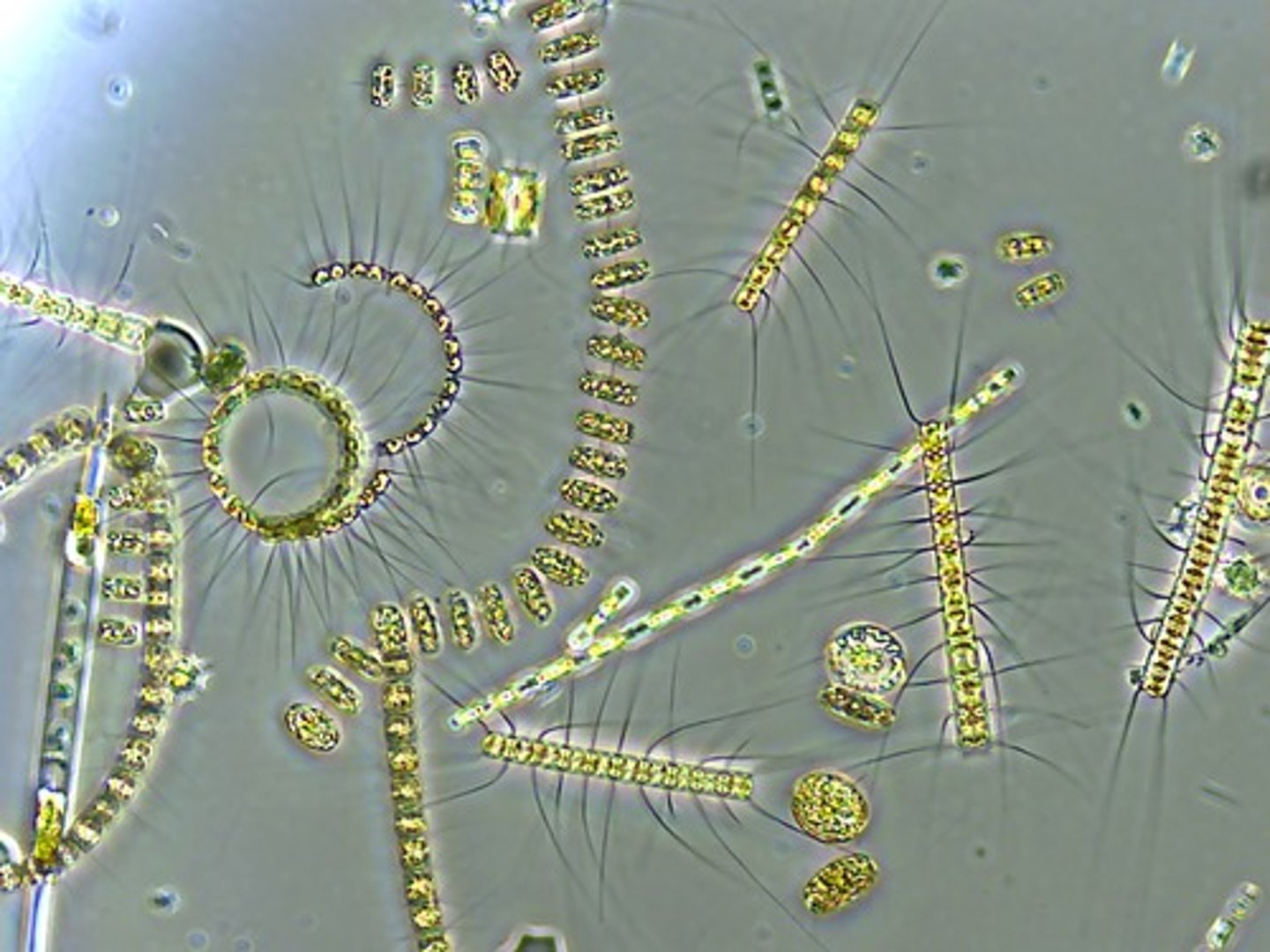
What is respiration?
- when glucose and oxygen react together in cells to produce carbon dioxide and water
- releases energy
- occurs in all living cells
- essential for life
- releases carbon into atmosphere
What is decomposition?
- when dead organic matter breaks down into organic carbon
- in soil carried out by soils organisms
- recycling carbon from living matter back into the atmosphere
What is photosynthesis?
- land plants absorb carbon dioxide from the atmosphere and combine it with water to form carbohydrates
- moves carbon from atmosphere into the biomass store
What is oxidation?
- when soil carbon is oxidised to become carbon dioxide
What is chemical weathering?
The breakdown of carbonate rocks often by carbonation which releases carbon into streams and rivers as bicarbonate ions
What is outgassing?
- when carbon rich sedimentary rocks are subducted into upper mantle and carbon dioxide is 'outgassed' at subduction zones
- heat and pressure of the subduction zone metamorphoses carbonate rocks into silicates releasing carbon dioxide
What is combustion?
- the process of burning something
- includes both natural wildfires set off by lightning and burning of fossil fuels
What is the natural greenhouse effect?
- the process by which the Earth's atmosphere warms the Earth and keeps the planet habitable
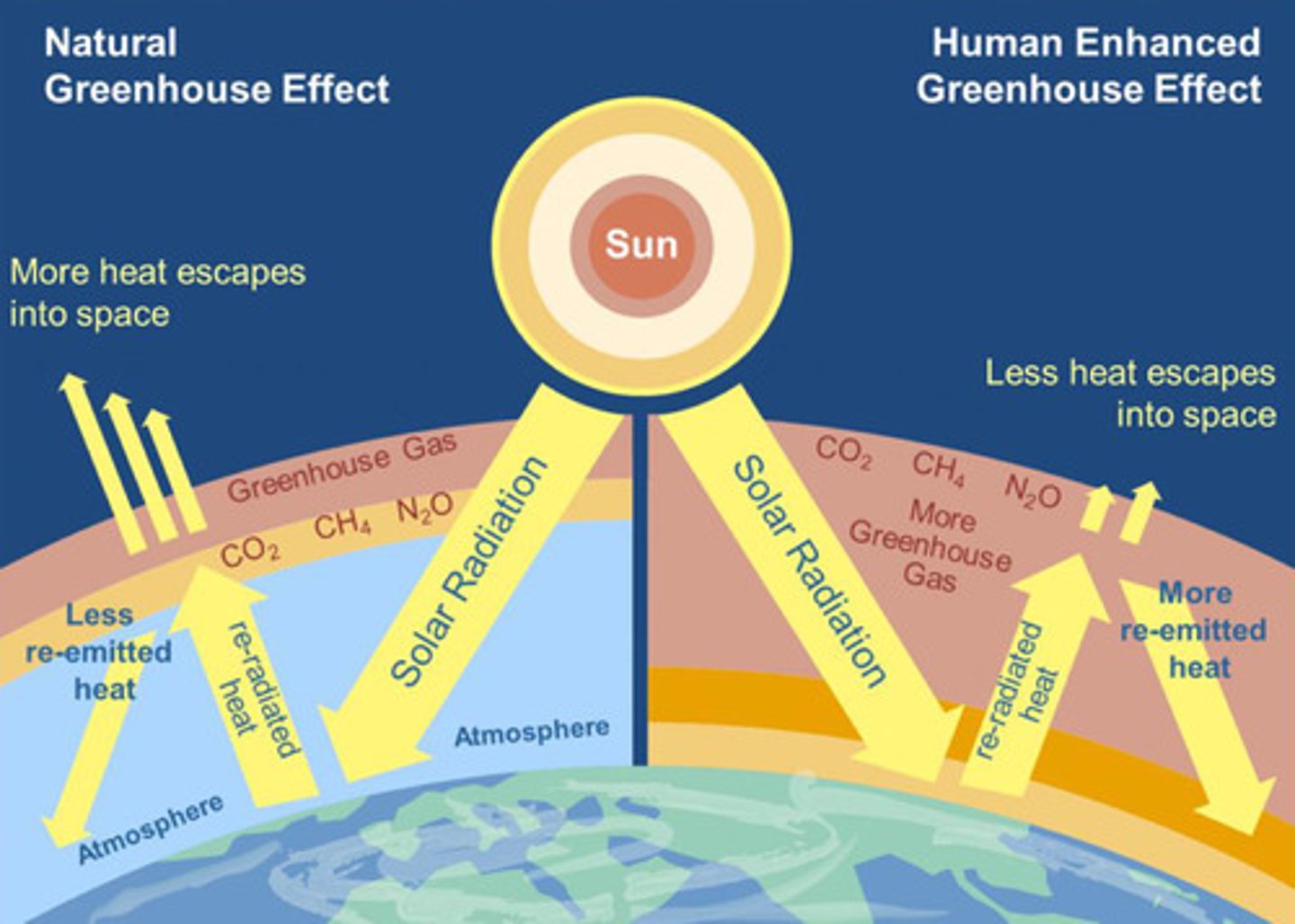
What is the enhanced greenhouse effect?
- HUMAN ACTIVITY (ANTHROPOGENIC)- is
changing the composition of the atmosphere and making it more effective at trapping heat
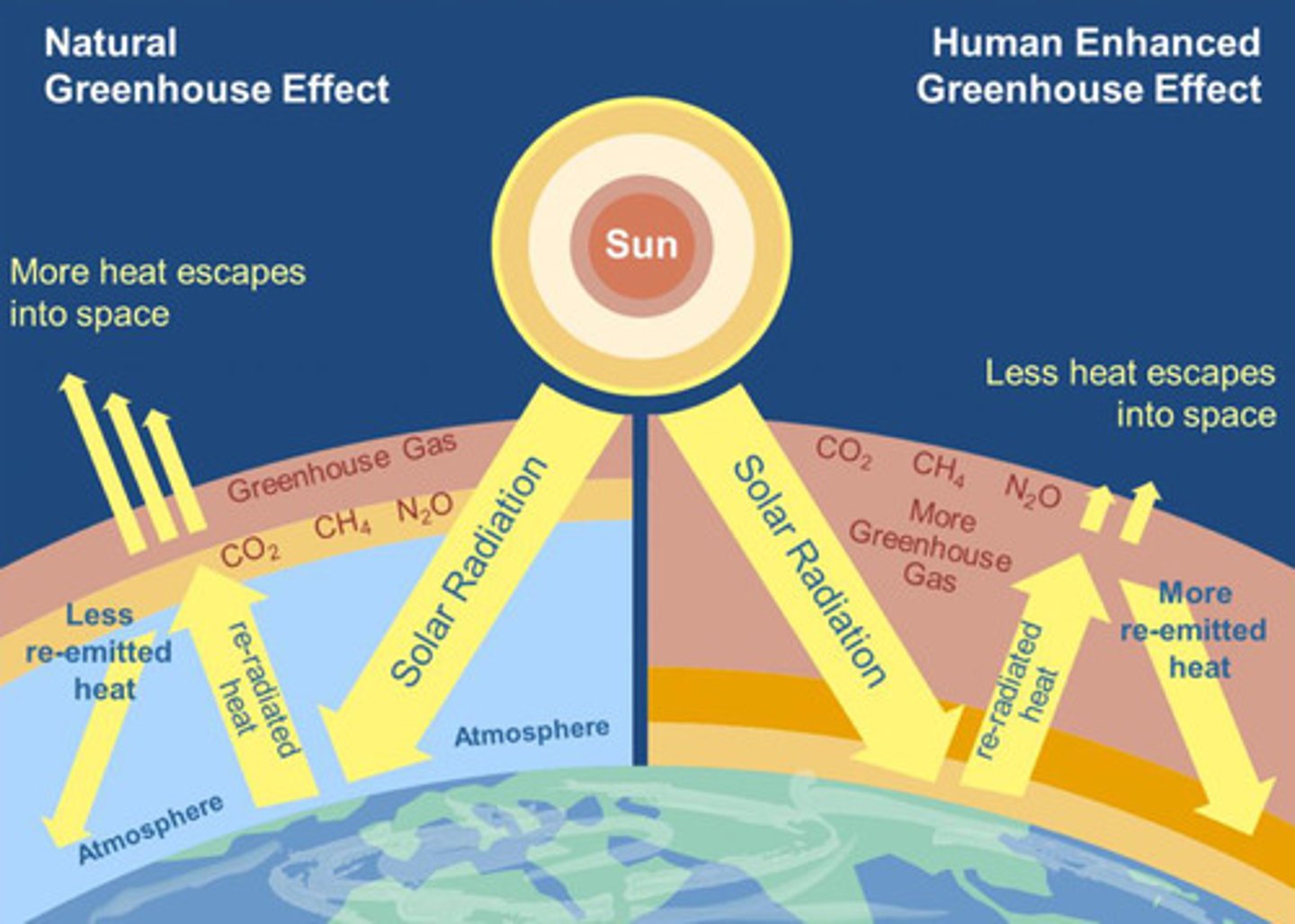
Explain the natural greenhouse effect?
- sun emits short wave radiation (ultraviolet) to earths surface
- most of radiation 49.1% absorbed = surface warms
- radiation not absorbed reflected 8.1% back up towards greenhouse gases as long wave infrared radiation
- infrared emitted through the atmospheric window or towards clouds
- at clouds radiation absorbed an emitted by the clouds
-emitted by atmosphere
- counter radiation also occurs= some radiation emitted back to the earths surface causing it to be rewarmed
What are the two main anthropogenic causes of climate change?
- increased greenhouse gas emissions leading to enhanced greenhouse effect
- destruction of natural carbon sinks
What is carbon dioxide?
- naturally occurring gas in the atmosphere
- produced by organic respiration and decomposition of organic material
What is methane?
- naturally occurring gas
- produced by anaerobic decomposition of organic matter and fermentation in animals
Destruction of carbon sinks
- carbon dioxide sinks store carbon dioxide away from the atmosphere so does not contribute to greenhouse effect
- deforestation causes the carbon being stored to be released
- permafrost melting so carbon dioxide stored underneath being released
What is energy security?
- to have access to reliable and affordable energy sources
How can countries be defined as energy insecure?
- if they don't have access to reliable and affordable energy sources
What is primary energy?
- natural energy resources that have not been converted into another form of energy
- includes non renewable resources such as fossil fuels, nuclear and renewables such as hydro, biomass, solar and wind
What is secondary energy?
- refers to what the primary source has been converted into, usually electricity
What does the term power generation mix refer to?
- the combination of energy resources used in electricity
What does energy mix of a country depend on?
- availability of primary energy resources within country, incl. technology to extract and use them
- accessibility of primary energy resources from outside the country
- real or perceived energy needs of the country
- changing energy consumption patterns
- national and regional policies
- cultural and historical legacies
- financial cost
What is an energy player?
- someone/thing that has a role in securing pathways and energy supplies
What are some players in the oil industry?
- cartels (OPEC)
- state controlled companies
- governments
- TNCs
-consumers
What is the role of a cartel?
- control the demand of products
- try to keep price high
What is a cartel?
- association of producer or supplies for led to mono police the production and distribution of a product or service to control prices etc.
What is OPEC?
- Organisation of the Petroleum Exporting Companies
- cartel
- set up 1960 to coordinate member countries' oil policies
- aim to create stable income for oil producing nations by controlling output and prices
-
What is Gazprom?
-Russian Company founded in 1989
- business of extraction, production, transport and sale of natural gas
- reserves in Siberia, Ural, Volga regions of Russia
- 51% ownership by Government
- gas major Russian export- help trade balance and earning revenues to help Government develop country
What is an energy pathway?
- the route by which an energy type is transferred from the production area to the consumption area, such as by pipeline or shipping route
ESPO pipeline
-EAST SIBERIAN-PACIFIC OCEAN
- starts in Russia
- Delivers oil to china but potentially to Japan and South Korea as well
- completed in 2014
North American Pipeline
- starts in Alberta, Canada
- delivers oil to Illinois and Oklahoma
- completed 2009-2012
What is the impact of the North American Pipeline?
- extensie use of shale on North American continent
- allows for reduced need of oil from non- North American sources
- significant businss for US refineries
What are some common misconceptions about oil?
- all oil is the same
- OPEC sets oil prices
- Governments sets oil prices
- oil used to generate electricity
- oil will run out when we reach peak oil
- oil comes in barrels
Where is oil found?
- porous reservoir rocks, often with green gas about, trapped by an impermeable cap rock
What is the rock under oil when being stored called?
- source rock
What is deep water oil?
- found in the Gulf of Mexico
- largest and deepest oilfields
Where are oil shale and shale gas found?
- tightly bound between rocks
- require fracking to extract
Where is tar sands found?
- tar deposits
What are shale gas environmental costs?
-banned in many countries
- gas could escape and pollute grand water aquifers
- chemicals used in fracking could enter groundwater and the wider hydrological cycle
- methane leak into air
- generates earth tremors
- uses huge quantities of freshwater
What are tar sands?
- mixture of clay, sand, water and bitumen
- has be taken from an open pit or strip-mined as too thick to be taken from the ground
- at least $120 a barrel
What is oil shale?
- contains solid bituminous material that is formed when silt and organic matter were heated and pressurised under water
- can be mined but must be heated to a high temperature to release oil
What is shale gas?
- natural gas (mainly methane) trapped inside impermeable shale rocks
- can not be extracted by normal drilling instead rock must be broken to free the gas - fracking
Fracking USA- Key Facts
Economic
- led to North American bloom in oil and natural gas production
- produce 11 billion barrels a day - North America
- world's demand for oil staying same or increasing
- diesel demand to increase
- Improves local and national economy
Social
-Landowners can make A LOT of money selling land to oil companies
-Provides jobs
Fracking USA- negatives
Economic
- maintaining high output require continuous investment in drilling new wells to compensate declines of existing ones
- natural gas extremely expensive
Environmental
- carbon dioxide emissions continue to increase
- Pollutes groundwater which can harm plants and animals
-On surface infrastructure can lead to deforestation and pollution
Social
- Local residents water has been polluted and is unsafe to drink
- Causes minor earthquakes
- Local residents claim their has been an increase in poor health
Implications for Carbon Cycle
- Extraction and transportation rises emissions
Athabasca Tar Sands, Canada
- The world's largest industrial project
- The oil sands are the 3rd largest proven oil reserve in the world
- Alberta there is reserve of 170 billion barrels of oil
- The oil is extracted by opencast mining, the extracted material is then mixed with water and the bitumen separated
- operations regulated by national and provincial bodies and regulations.
- Alberta has become a boomtown with population rapidly increasing in the last 10 years
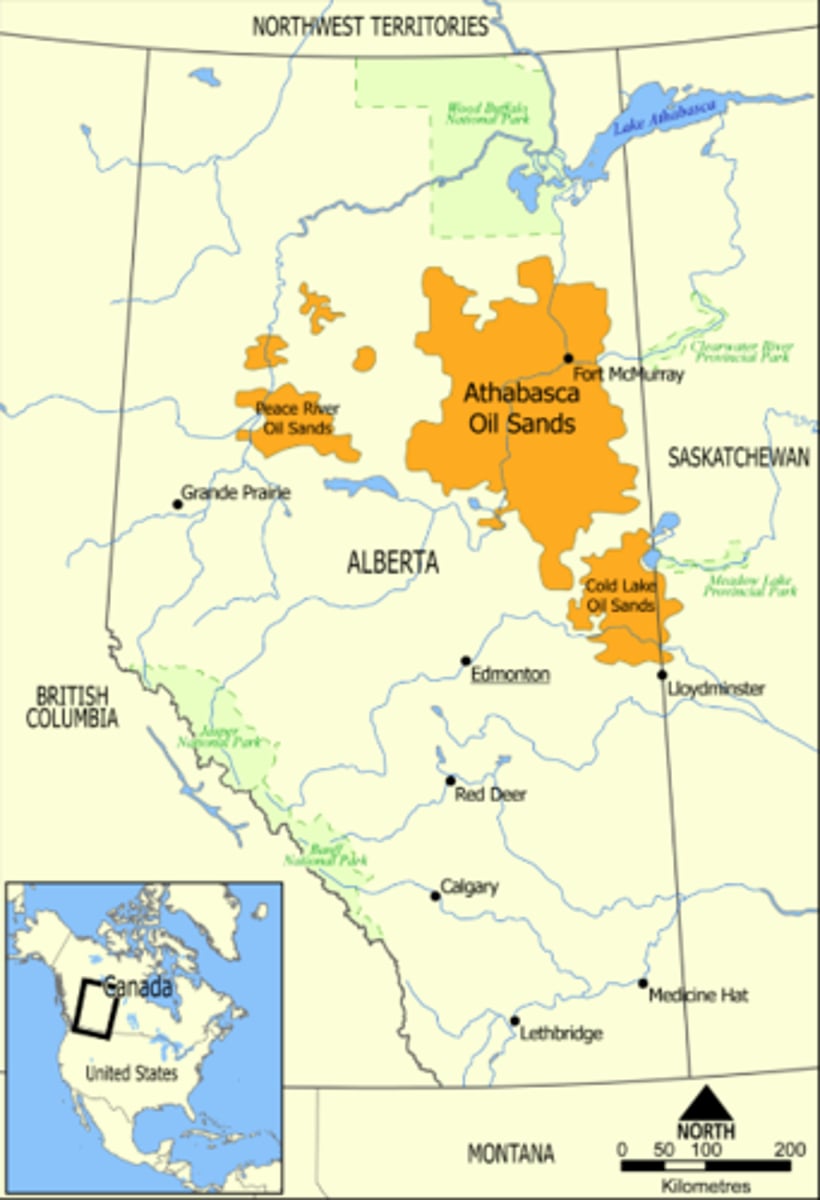
Tar Sands, Canada- Positives
Social
- New jobs in an area where there isn't a lot of opportunities
- high paid work (at least $2000 a week)
- Oil sands Community alliance been set up to provide service and facilities for local people
Tar Sands, Canada- Negatives (Social)
Social
- Process uses land that was once home to indigenous people: disruption to traditional way of life
+Fort Mackay: traditional hamlet, surrounded by oil companies,air pollution + asthma, now have to buy water
- Produces atmospheric toxins and an increased incidence of rare cancers and auto immune diseases in local residents
- Gambling, substance abuse and crime has increased in the area
- There is now a housing crisis as thousands of workers have moved to the area
-Someone gets killed every week on the roads to the oil fields
Tar Sands, Canada- Negatives (Environmental)
- Opencast mining destroys forests and peat bogs
- Boreal forest larger than the Amazon being destroyed: loose habitats, traditional traplines disturbed
- extraction creates spoil heaps
- Tailings ponds are created, which contain contaminated waste water
- Since 1979 1 million acres have been developed, only 256 acres redeveloped (PR front)
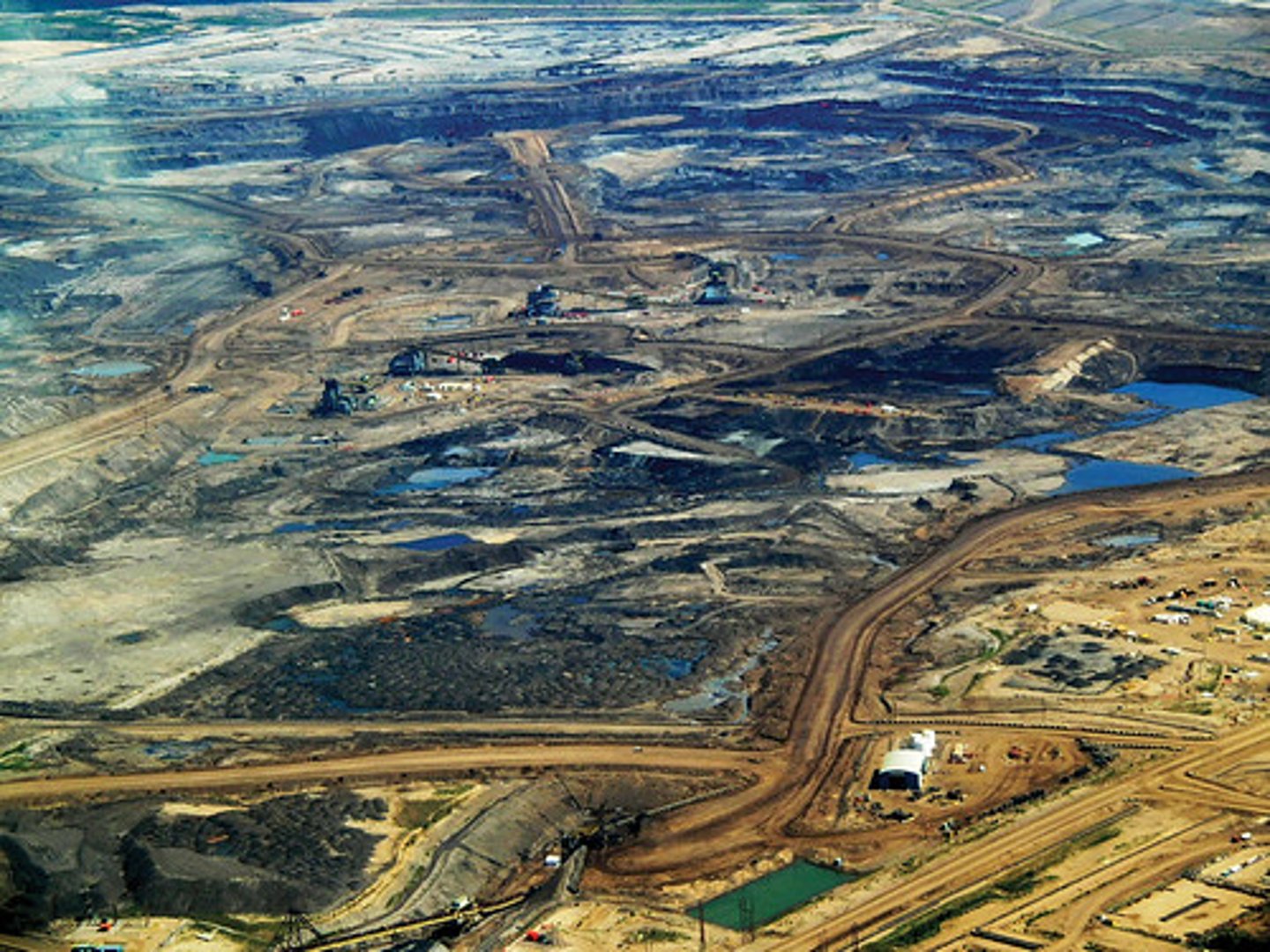
Tar Sands, Canada- Carbon Cycle Implications
- Carbon emissions rise due to extraction, production and use of the oil
- Emissions are equivalent to 1.4 million cars, in a day
- carbon absorption falls due to the use of the oil
- Largest source of growth of CO2 emissions in Canada
Athabasca Tar Sands- Players
Oil companies- produce crude oil from oil sands which has a positive impact on Canada's economy
Governments- promote tar sands for energy security and economic development
Environmental pressure groups- object to the 'industrialisation of indigenous territories, forests and wetlands'
Local communities- have both costs and benefits
Deep water oil, Brazil
-Brazilian state company Petrobas began developing deep water oilfield 2006
- estimated reserves of 50-80 billion barrels
- 200-300km offshore where seabed at depth of 2000m
- In 2015 production reached 885,000 barrels a day
Deep water oil, Brazil- negatives
Economic
- costs very high
-by 2016 Petrobas was $100 billion in debt due to lower global oil prices
Social
- Debt caused job losses
- Drilling is dangerous for workers and the journey to the rigs is across treacherous seas
- People worry what will happen if there is an accident like Deep Water Horizons rig (2010)
Environment
- Possible oil spills could be catastrophic
Implications for Carbon Cycle
- Extraction and transportation rises emissions
Deep water oil, Brazil- positives
Economic
- Helps fill the demands of Brazil's growing population and diversify its energy mix
Social
- Creates jobs
Benefits of developing solar energy?
- safe,clean and non-polluting once made and installed
- renewable
- can be used by poorer countries
- links well with other sources of energy
- flexible and modular
Problems of developing solar energy?
- not enough research and development into storage methods
- electricity produced initially more expensive than from conventional power stations
- not effective in cloudy climates or polar latitudes
- energy needs to be stored for later use
What are some advantages of biomass?
- renewable
- no harmful gases produced
- cheap
- produces oxygen
- reduces landfills
What are some advantages of solar power wind energy?
- renewable
- no emissions that pollute
- low maintenance costs
What some advantages of wave and tidal energy?
- renewable
- clean source
What some advantages of Hydro-Electric power?
- clean power source
- domestic source of energy
- no pollution
- creates reservoirs
What are some advanatages of nuclear power?
- does not produce CO2
What are some advantages of heat recovery systems?
- renewable
- cheap - reduce bills
What are some disadvantages of biomass?
- take up lot of space
- cause major pollution
- needs pesticides and fertiliser
- large volumes of water needed - loss of carbon sink
What are some disadvantages of solar power wind energy?
- expensive to set up
- weather dependent
- large space needed
What are some disadvantages of wave and tidal energy?
- unreliable
- high upfront cost
- limited suitable locations
What are some disadvantages of Hydro-Electric power?
- decreased water quality
- depends on amount of water available
What are some disadvantages of nuclear power?
- non renewable
- could lead to radioactive material being released
- remains radioactive for years
- hard to store
What are some disadvantages of heat recovery systems?
- initial cost expensive
- need replacing regularly
What is strike price?
- government guarantees a minimum price per mega watt hour (MwH)
CASE STUDY: changing UK energy mix
- delcline in role of coal but oil remained constant
- natural gas increase until 2005 then decline
- renewables grown majorly
CASE STUDY: Biofuels in Brazil
- sugar cane used to produce ethanol instead of sugar
- biorefineries produce 930,000 barrels a day
- worth $50 billion a year
- provides 1.34 million direct jobs
What is carbon dioxide sequestration?
- process of storing it away
- removes from atmosphere
What is mitigation?
- ways in which people can reduce human impacts on climate by reducing emissions and creating or enhancing stores of greenhouse gases
What is carbon taxation?
- taxes placed on carbon by the Government
- e.g congestion and emission charges, road tolls, taxes on vehicles/ vehicle fuel
- KEY PLAYERS: OCEDS, farmers, government
What are some positives of carbon taxation?
- encourage use of alternatives
- raise revenue
- socially efficient outcome